Opened 1911 | ||
 | ||
Similar Hamilton County Memorial, Motr Pub, Cincinnati Music Hall, Know Theatre of Cincinnati, Washington Park | ||
Emery theatre
The Emery Theatre, or Emery Auditorium, is a historic, acoustically exceptional theater located in the Over-the-Rhine neighborhood of Cincinnati, Ohio. The building was constructed in 1911 as the home for a trade school (the Ohio Mechanics Institute), but its large, impressive auditorium was intended for public use. The design of the Emery Theatre is based on the "isacoustic curve" principles that were first proposed by John Scott Russell. The theatre was built with two balconies and a total of 2,211 seats. It was one of the first concert halls in the United States to have no obstructed seats.
Contents
- Emery theatre
- Emery theatre let s all go to the lobby
- History
- Design
- Timeline of Ownership
- Recent community use of the theatre
- Past revival efforts
- Current revival plan
- The Requiem Project
- References

The Emery was the home of the Cincinnati Symphony Orchestra, who performed there from January 6, 1912 until 1936 when they moved to the larger Music Hall. The quality of acoustics in the Emery Theatre is legendary. The famous conductor Leopold Stokowski compared its acoustics to that of Carnegie Hall in New York City.
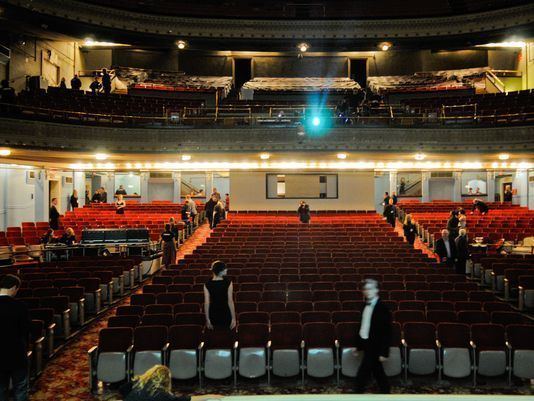
Many world-renowned performing artists and Broadway stars have appeared at the Emery, including George Gershwin, John Philip Sousa, Bette Davis, Arturo Toscanini, Fritz Reiner, Katharine Cornell, and Russian ballet dancers Nijinsky and Anna Pavlova. Gershwin performed Rhapsody in Blue there with the Cincinnati Symphony Orchestra shortly after premiering it in New York City.
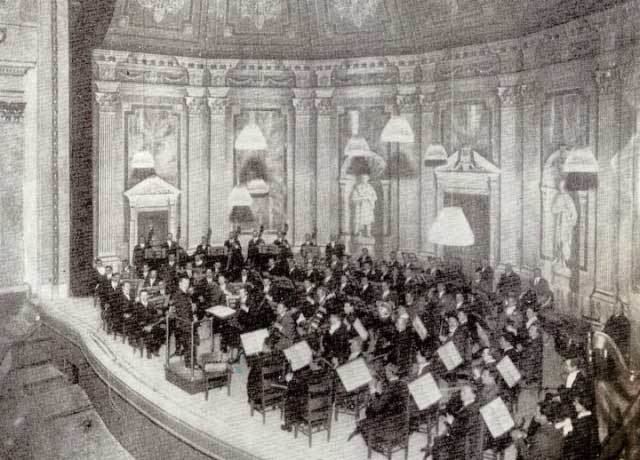
The Emery Theatre has fallen into disuse, but there is a long-standing community interest in restoring the historic auditorium as a mid-sized performing venue. A modern restoration of the theatre would allow seating for approximately 1,600 guests. The current revival effort aims to see the theatre restored as a community arts venue.
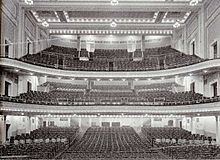
Emery theatre let s all go to the lobby
History
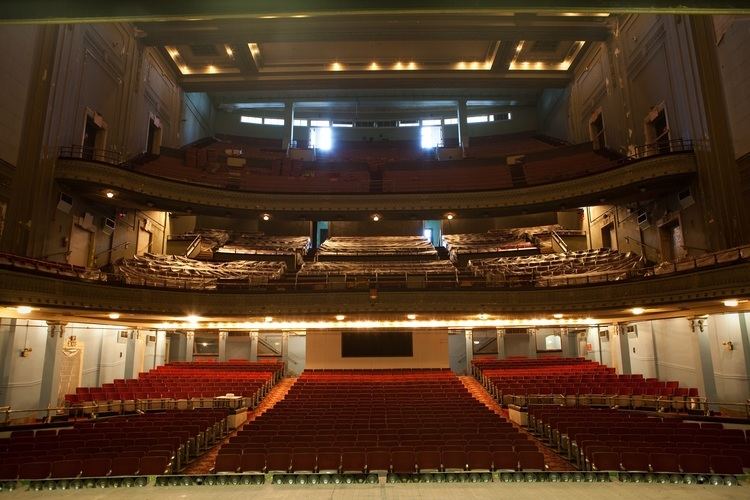
The Emery Theatre was the third in a series of four theatre-style concert halls whose design was derived from Adler and Sullivan's Auditorium Theatre in Chicago, and that were specifically built for the symphony orchestras of their respective cities. The four halls were Carnegie Hall in New York City (1892), Orchestra Hall in Chicago (1904), Emery Auditorium in Cincinnati (1911), and Orchestra Hall in Detroit (1919). Unlike its three sister halls, the Emery Theatre is not freestanding, but is part of a school building. The school was the Ohio Mechanics Institute (OMI), now known as the Ohio College of Applied Science.
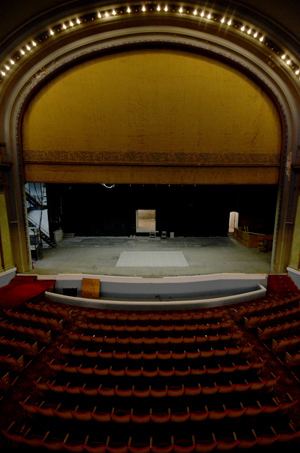
By the early 1900s, the OMI's need for a new and larger building was imperative. Preliminary plans were first made public in a promotional brochure, which appeared in the spring of 1906. This brochure showed a four-story building with a small stage, limited backstage facilities, and seating capacity of 1,280, which would have precluded its use by any large-scale theatrical or concert productions. However, outside influence was soon felt in the form of Mrs. Mary M. Emery's philanthropy.
Initially, Mrs. Emery offered to fund only part of the project, but OMI Superintendent John L. Shearer induced her to take on the entire cost of the project and make the whole building a memorial to her husband. Mrs. Emery only asked that the auditorium be "so constructed as to be serviceable for public and private lectures, entertainments, symphony and other concerts. May Festival rehearsals, and for such other entertainment as in the judgement of the Trustees of your institution may be proper." She avoided mention of the Cincinnati Symphony Orchestra, which she hoped would be the new hall's main tenant.
Thanks to new management and a need for a smaller concert hall, the CSO eventually made Emery Theatre its home. The original plan for 1,500 seats would not, however, be enough. A second balcony was added, and the final design helped to make the Emery the first concert hall in the United States to have no obstructed seats.
Design
Adler’s design helped Harvey Hannaford with the design problems of the Emery Auditorium. Adler used the principle of the "isacoustic curve" first described by John Scott Russell in 1836 not only to calculate the best placement of the Auditorium's main floor and its three balconies, but also to design a series of terraced ellipses that form the ceiling in the front part of the hall. These ellipses helped direct sound evenly throughout the hall. They serve the added function of lessening the overall volume so sound in this large hall is not boomy or cavernous but still resonant, especially for the audience in the second and third balconies.
The final 1911 Emery Auditorium design is derived from the 1909 design. Hannaford made the ellipse shallower, shifted the three coffered ceiling segments toward the stage, and added in the back of the hall a smooth ceiling which is rounded in the front. The ellipse was now the same as Music Hall's ellipse.
The two massive balconies are the most wonderful structural aspects of the 1911 design. Viewed from the stage, the balconies appear to be strung effortlessly between the walls of the hall. Their "secret" lies in two I-beams of structural steel, one for each balcony, over eighty-nine feet long and weighing thirty-three tons each, running the width of the hall. The balconies rest largely on these beams. The beam for the second balcony is tied directly into the back pair of the hall's four main support columns. The anchorage for the lower balcony's beam is less obvious. It appears to float above the main floor because it enters the walls immediately above two sets of exit doors. Actually, it is riveted at both ends into plate girders that span the doors like lintels, and which are in turn attached to the support columns. These plate girders are completely covered over by masonry. An intricate system of cantilever trusses extends out from these I-beams to form the front part of the balconies. This method of balcony construction was relatively new in 1910 and had, to the author's knowledge, never been used in a concert hall in the United States prior to the Emery Auditorium. Its use in two balconies adds further precedent to the Emery's design.
In regard to acoustics, Leopold Stokowski commented on the hall's excellent combination of clarity and blend, and the effective increase in the orchestra's power. Individual instrumental colors could now be heard with greater resolution because of the greater logistical intimacy between audience and orchestra, and because the hall's shape and dimensions created a less diffuse sound, while at the same time creating resonance which blended the clearer, more powerful sound into a well-balanced whole. Unfortunately, we have no record of the Cincinnati Symphony Orchestra’s sound in the Emery, as they made no commercial recordings and no radio broadcast transcription disks are known to exist from the period the orchestra performed there. [13]
Timeline of Ownership
1969 —The University of Cincinnati gains ownership of the building that houses both the Emery Theatre and the Emery Center Apartments after OMI-CAS (Ohio College of Applied Science) becomes incorporated into UC. [3]
1977-1999 —The American Theatre Organ Society managed the theatre and reduced the seating capacity to 1,360 by closing the second balcony to the public. During this period, silent, sound, and 3D films were shown during the weekends, and organ concerts were performed several times each year.
1988 —OMI-CAS moves to Edgecliff Campus, and the non-theatre classroom portion of the building sits vacant. [3] The University of Cincinnati remains the owner of the building.
1988 —The non-profit Emery Center Corporation (ECC) is created to promote the restoration and sustainable operation of the Emery Theatre. The ECC still maintains the lease for the auditorium portion of the building today.
2001— The Emery Center Apartments Limited Partnership (ECALP) leases the building (excluding the theatre) from UC in order to redevelop the building into market-rate rental apartments and commercial spaces. [3][10] The theatre portion of the building remains in need of major renovation and continues to be unused.
2008 —A group of over 100 local volunteers from Give Back Cincinnati spends a day cleaning up the dusty theatre.[12][13] In November, the Cincinnati Entertainment Awards are held at the Emery.[14]
2009 —The ECC begins to develop plans to sublease the theatre to the nonprofit The Requiem Project.
Recent community use of the theatre
Despite the theatre's condition, temporary occupancy permits have been obtained over the past several years to allow the following activities:
Past revival efforts
Current revival plan
The non-profit Emery Center Corporation (ECC), formed in 1989, is responsible for re-opening the theatre. In September 2009, the ECC began to work with a non-profits arts company, The Requiem Project, a site-specific non-profit dedicated to the permanent re-establishment of The Emery Theatre, The revival of the Emery Theater is now referred to as "The Requiem Project: Emery Theatre."
Founded in 2008 under the artistic direction of Tina Manchise and Tara Lindsey Gordon, The Requiem Project is a revitalization plan and re-programming of the Emery Theatre, both as a multi-purpose arts venue for diverse and innovative arts programs at an affordable cost, and as an educational resource center for professional development of artists. In addition to opening the theatre’s 1600 seat auditorium for live performances and films, The Requiem Project's programming focuses on increasing employable skills for working artists through teacher certifications in the movement arts, such as Pilates and yoga, and fine arts classes in dance, music, and writing.
The renovation of the Emery Theatre intends to open the building in modular phases, with a full-scale renovation that will include gallery space, a sculpture garden, dance studios, music rooms, alternative performance spaces, and event rental space.
Under the direction of The Requiem Project, two architectural firms were hired to assist in creating the outline and renderings for the overall for the reconstruction project. The firms are John Senhauser Architects, and Westlake Reed and Leskosky. Westlake Reed and Leskosky specialize in the revitalization in historic theatres (The Emery will be the 74th theatre associated with the firm), and Senhauser Architects are historic preservation specialists.
The first event to be held at the Emery under The Requiem Project’s artistic direction was the “11.11.11,” a preview of the Emery and an introduction to the four avenues of the company's public mission, which is the development of an innovative arts destination as a space for creative possibility with the belief that meaningful artistic interactions create community.
The Requiem Project
One-Year of Continuous Programming
An invaluable step in the overall revitalization project was the sponsorship of one-year of programming (November 2011-November 2012), with the inaugural event being held on November 11, 2011. This event was titled “11.11.11, A Preview of The Emery.” The intent of the “11.11.11” event was to introduce to the community to the kind of programming that could and would happen at The Emery, and to the collaborations and productions that The Requiem Project envisioned at The Emery.
The intention behind the 2011-2012 year of programming was bi-fold; to highlight the value of The Emery to the local community prior to launching a Capital Campaign, and to demonstrate that the operation of the theatre was a viable business venture. The goal was to illuminate to the community how The Emery could identify itself in Cincinnati, as well as to collect data regarding patron and community support, demographic reach, etc. The information collected in this step helped to provide reliable statistics and a constituency of support that is integral to the implementation of the Capital Campaign.
Among the artists that performed during the first year of programming were The National, Bill Frisell, Dirty Projectors, and Ralph Stanley. The Emery also hosted a film premiere, the Cincinnati Film Festival and the Cincinnati Fringe Festival. Additionally, in collaboration with the Cincinnati Contemporary Art Center, the Emery hosted 13 Most Beautiful Songs for Andy Warhol’s Screen Tests performed by Dean & Britta.
Under the direction of The Requiem Project in 2012 The Emery Sessions were commissioned. Emery Sessions are a series of single take (one shot), high-fidelity music videos shot throughout The Emery by acclaimed rock-n-roll photographer Michael Wilson with audio recording by Cameron Cochran, audio mixing by Henry Wilson, and titles and digital juju by Matthew Davis. Sessions have already been filmed with Over The Rhine, Ralph Stanley, Daniel Martin Moore, The Comet Bluegrass All-Stars and many more. All the Emery Session videos are available on YouTube.
